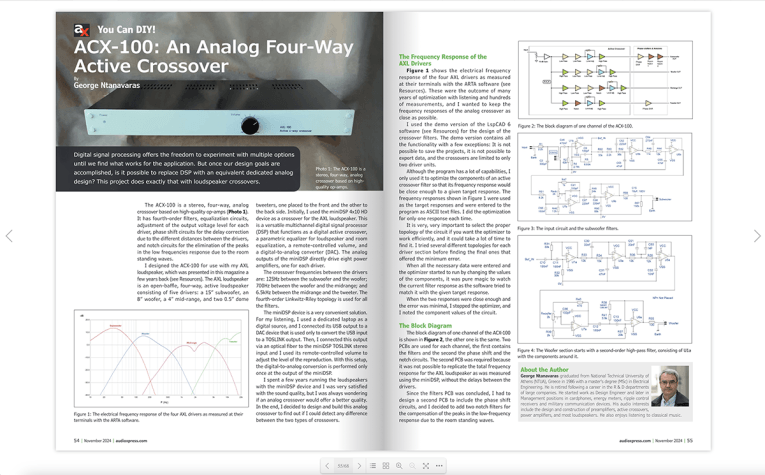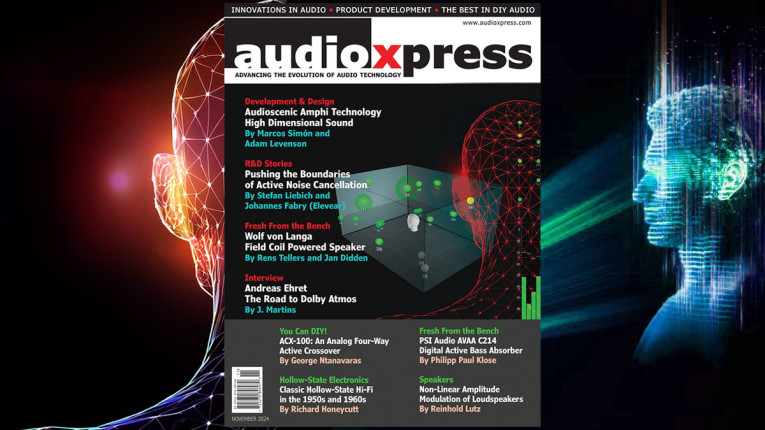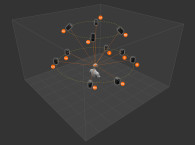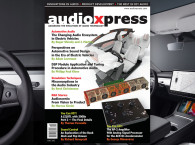 For this November 2024 issue, audioXpress has combined great articles on audio development and design, new perspectives on signal processing, speaker design, and sound reproduction.
For this November 2024 issue, audioXpress has combined great articles on audio development and design, new perspectives on signal processing, speaker design, and sound reproduction.And this issue kicks off with a thorough review by Philipp Paul Klose of the intriguing AVAA C214 Digital Active Bass Absorber from Swiss studio monitor and high-end speaker specialist PSI Audio. The concept is more or less the same as the AVAA C20, which PSI launched in 2017 and was the first commercially available analog active bass trap. This product demonstrated how these patented active acoustics devices absorb undesired room modes in studios, being as efficient as passive absorbers many times their size. Now, with the latest AVAA C214, PSI has introduced a digital controlled active bass trap that's better suited to deal with room modes below 150Hz in listening spaces and small studios rooms. Klose tried it in two different spaces and applications, measured it and shares what he learned.
Next up, Marcos Simón and Adam Levenson bring us a Development and Design story, where they describe how Audioscenic's Amphi Technology effectively enables an evolution in 3D sound and its reproduction through loudspeakers. Audioscenic developed a sound reproduction technology that allows for the real-time adjustment of spatial audio systems, providing an effective and natural ability to hear in three dimensions without the need for the listener to be constrained within a specific sweet spot. The article explains the advantages of the technology and its unique position-adaptive 3D sound, compared with other 3D sound technologies.
And proceeding from a different perspective on signal processing, Stefan Liebich and Johannes Fabry bring us the story of how Elevear is Pushing the Boundaries of Active Noise Cancellation (ANC). A must-have feature in current devices, ANC has revolutionized the way we experience audio, allowing listeners to immerse themselves in music or podcasts without the interference of ambient noise. Offering a great overview about how signal processing works for ANC and transparency in true wireless earbuds, the two Elevear technical minds share their perspective on how the technology roadmap is taking us in exciting directions.
And to provide even more context on signal processing and audio reproduction, J. Martins engaged in a fascinating conversation with Andreas Ehret, Senior Director, Automotive at Dolby Laboratories. In this interview, Andreas Ehret recaps his career and personal journey prior to and with Dolby, through truly pivotal moments in audio history. In this exchange we learned how Dolby Atmos evolved from the ultimate movie soundtrack format into the heart of consumer experience - for the very first time successfully challenging stereo reproduction. And how Dolby evolved its business model to become today's indispensable technology partner to both the media and the automotive industry, to the point of redefining automotive entertainment. Truly insightful details about Dolby's fascinating path in a unique perspective.

And from sound reproduction to speakers, Rens Tellers and Jan Didden write about Field Coil Powered Speaker Drivers, one of the oldest loudspeaker designs. This somewhat unusual topology is touted by those who have explored it as outperforming traditional permanent magnet drivers. On the other hand, they need an extra power supply and are relatively expensive. Following a presentation by Wolf von Langa, a renowned designer and manufacturer of premium loudspeakers who pioneered the use of field coil drivers, Rens Tellers and Jan Didden offered to do some technical measurements on one of his drivers, to which Wolf graciously agreed. In this article they share their test bench findings.
Next up, Reinhold Lutz brings us another great contributed piece, this time discussing Non-Linear Amplitude Modulation (NLAM) of Loudspeakers. As he has addressed in previous articles, even a perfectly linear loudspeaker produces two types of distortions because of the movement of its membrane. First, Doppler distortions, a.k.a. Phase Modulation (which he addresses in his October 2024 article for audioXpress), and second, distortions stemming from the Nonlinear Amplitude Modulation, characterized in this article. More importantly, Lutz also addresses how these harmonic and intermodulation spectral line distortions can be minimized and eliminated.

And still related to speakers but this time focusing on a practical DIY project, George Ntanavaras shares his high-quality Analog Four-Way Active Crossover, ACX-100. The premise for this project is extremely original since Ntanavaras designed the ACX-100 to replace his original DSP-based solution that he had been using with good results. The ACX-100 is a stereo, four-way, analog crossover based on high quality operational amplifiers. It has fourth-order filters, equalization circuits, adjustment of the output voltage level for each driver, phase shift circuits for the delay correction due to the different distances between the drivers and notch circuits for the elimination of the peaks in the low frequencies response due to the room standing waves. The project was designed for use with the author's AXL loudspeaker, which was already presented in audioXpress, September 2019.
And to close this november 2024 audioXpress issue in an engaging way, in his Hollow-State Electronics article, Richard Honeycutt revisits some great hi-fi tube classes from the 1950s and 1960s. This article expands on the article published in June 2024, which discussed the history of home music reproduction systems from the late 1920s, and pre-hi-fi AM radio days, until the early 1950s. In this new exploration of audio history, he picks up where that one left off and carries the story forward, from the late 1950s to early 1960s, revisiting great designs from Dynaco, Harman Kardon, Lafayette Radio, and Heathkit.

All the content contained in every issue of audioXpress is the reason this publication continues to reinforce its role as an essential resource for the audio industry, month after month, 12 times per year. Your support and that of our advertisers is what allows us to keep this publication in print and on all the digital platforms as well as pay our independent authors and contributors for their work.
Subscribe if you haven't done so in order not to miss future issues or renew your subscription. Subscribing to the digital online version allows immediate access and is available here: audioXpress Subscription Services
If you wish to buy a single printed issue or the complete audioXpress archive on USB, from 2000 to 2024 (yes, including the latest issue), just visit our online shop at www.cc-webshop.com
Don't miss out, get your copy of audioXpress right now at www.gotomyxpress.com






